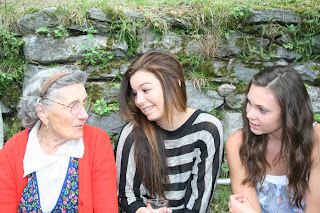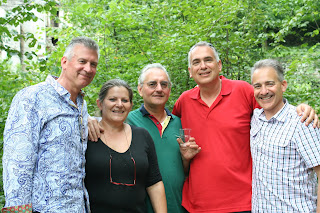It has been over three months since I last wrote of Veglio. My intention was to write more frequently and to put down some of the thoughts that I had during the last construction trip but modern life has interceded.
 |
| My Office Looks to Flatiron |
I have been on a very fast treadmill that started just two weeks after I returned from the Mountain in late September. I have probably spent half the time in New York sprinting from meeting to meeting and dodging cars as I walked from Flat Iron to Midtown several times each day. Not a day goes by though when I don’t return in mind and spirit, if not body to our little village on the side of the hill.
It is often hard to reconcile the pace of modern life with the calling of my ancestors and the lessons that I believe they are trying to teach me somehow. Now that I am fifty I also think about the ticking of life’s clock. Am I going to have time to enjoy the slower pace of life? To learn how to make that polenta or salami or maybe even some wine? Does the significance of my work matter and is it worth the wear and tear that thousands of air miles and late nights in hotels inevitably take.
During the September trip, we needed to remove all of the debris that fell down when a large part of the bedroom roof collapsed. We estimated nearly 140,000 pounds of stone roof and wall were hauled by six hands and a three tired backs. These stones were comprised of large foundation rocks, medium sized stones that were stacked one on top of the other for the walls and then finally the flat rocks that are the roofing materials.
 |
| Our Starting Debris Pile--September 2011 |
The largest stones were probably over 150 pounds and were large rectangular blocks. The roof pieces were two inches thick and measured three feet by two feet for the most part. Since the roof collapsed three floors and a 30-foot long wall, we started with a very large pile of rubble. We not only needed to move the rocks, but also it was important to sort then in various sizes and shapes so that they could be reused at the appropriate time when we rebuild that part of the house.
The first challenge I had to tackle was in my own head. How was I going to move these rocks without injuring myself? A couple of mind games were waging. I had injured my right hamstring at Easter this year during a soccer match. I had ripped some of the tendons off the bone and was in physical therapy for the summer. When I had tried to lift something heavy earlier in the year, it was like a hot knife cutting into my groin so I was a bit hesitant to risk a re-injury. The second battlefront was my recent 50th birthday and the limits that I was putting on myself.
For the first halfday or so, I would only lift the small rocks and was reluctant to pick up the larger cornerstones that needed to be moved. Gradually though, I started testing myself as I saw my nephew pick up the largest stones and raise them three feet onto the sorting pile. I was further encouraged when we were joined by Daniel who was all of 65 years old and walked with limp and a stooped back. He, with proper technique, was lifting the largest of rocks with slow but deliberate movement.
 |
| Daniel, Age 65, Schooled Me! |
By the third day, my legs and back were stretched and working. With my fears conquered and a little bit of technique, I was not only keeping up but causing the passer-bys to ask about this American who supposedly worked a deskjob. It felt great, especially as we begin to see real progress. Structures began to emerge from the debris.
First, a staircase or scala that had lead up to the second story. Then, with enough digging we could see the outline for the two of the cellars that were used to store the entire winter’s food and wine supply. Finally, the large entrance that once was the primary access to the house. All in all, the collapsed section had one been four bedrooms, three cellars and a courtyard. With the existing damage, though, nothing more than the foundation, six crossbeams and the thousands of pounds of rock remained.
 |
| Staircase on Outside of Bedroom Floors |
So what did I learn from the September trip? More than once, my uninformed technique nearly caused a massive avalanche of stone until my nephew or cousin or Daniel would attempt to translate proper instructions. So here are a few tips that I picked up that I think may even have relevance back home in Orange County or maybe even the concrete and stone jungle of New York.
Don’t try to get to the bottom of the pile too quickly. As you can see from the picture below, the debris was formed like a giant hillside. We started at the bottom of the hill to remove the rocks. In my quest to reach the ground and pull all of the choicest stones out, I worked an entire morning digging at the base. When my architect nephew came by, he was aghast. I had left the weight of the upper section precariously unsupported by my efforts and was just a few stones away from pulling the entire massive weight of multiple tons down upon myself. The weight needed to be distributed evenly at a slope. Trying to get to the bottom of the foundation too early versus continuing to push the upper sections down was a near fatal mistake.
 |
| Andrea and the Rolling Stone |
Let gravity do its work in bringing the stones to the proper storage area. As I worked my way up the pile, I would lift and dig and pry large sections of stone free. Then, I would pick up 100 pounders and carry them down the hillside. Especially after the sun began to bake us, it was exhausting and also dangerous as I struggled to maintain my footing on the walk down. Again, Andrea introduced the concept of gravity to me! Go all the way to the top and get the large rocks rolling down. They will move the other medium and small rocks and pick up momentum. Sure enough, once I got them rolling they picked up speed and with a little steering would end up just a few yards from where I would them place them on storage pile.
Little rocks are just as important as the big ones. While we saw great progress when we would lift out a three foot by one foot stone from the dirt and dust, we also needed to collect the smaller rubble stones. All of the rocks in the house are handcut or more properly handsplit which means that no two are the same exact size. Setting a level floor or wall means wedging little rocks into the spaces created from the larger stones. Having a large collection of these rubble stones is essential in getting a structurally sound wall and for keeping out the elements. Mortar in the way we would think of it, is not used as it destroys the rocks over time. We took great care in sorting even the smallest of this “waste” rocks into their own areas that can then be used later.
 |
| Three Stories of Dry Stone--600 Years Old |
Holding the walls together with the natural forces create the strongest bonds. As I mentioned earlier, the “modern” technique of large amounts of mortar is discouraged in proper historical restoration. The preferred method is take the extra time to find the best fit rocks and then wedge the smaller stones for balance and filling. This ageless technique uses the weight of the stones and fitting to create bonds that can last thousands of years. Think Machu Picchu or the Pyramids. Had mortar been used, it would have long ago given way and in the process destroyed the rock with its acidic nature.
In a few days, I will oil up the treadmill and get back to my modern “proper” job. The most exciting event coming up, though is our next trip to Veglio in early May. All that stone we took out in September will be reassembled somehow into that 30 foot high wall. Three brothers along with Linda, Jocelyn, Allyssa, Alex and perhaps a few younger backs will be charged with putting Humpty back together again. I am sure we will learn a few more lessons about ourselves, our ancestors and our mountain.
























